September is certainly the prime time in South Luangwa; the lagoons are all but dry and all game is concentrated along the river. The riverine forests teem with antelope and elephants searching for forage from the sausage trees, starlings feed noisily from wild mango flowers and among the fruiting ebony trees, and the sense of predators is everywhere.



All the floodplains along the river are rich with game, cropping the short grass ever shorter; warthogs, zebras and large buffalo herds vie for the sustenance and baboons meander between them feeding on the grass roots.

Where prey leads, predators follow and this is certainly a fantastic time of year to photograph large carnivores in the Luangwa. Driving carefully along the river just after dawn, stopping to read the signs of the bush, we can almost certainly pick up warning calls that will lead us to a leopard patrolling through her territory before seeking refuge in a large tree, or to lions settling down along the bank.

With water levels so low, the river no longer acts as an impediment and animals cross freely. Lions sometimes cross to compete for the carcasses of lion prides on the other side. There is drama at this time of year, and wonderful, reliable sightings.





Predators come into contact at this time of year in a way that we don’t see when there is more water around. Lions, hearing the sound of a leopard making a kill, will rush over to investigate and try to steal the prize. Wild dogs, in their long-legged hunting mode, will flush a leopard and pursue it up a nearby tree.


The light is soft and smothering, wrapping subjects in a soft, golden glow. This allows classic African safari images, but makes backlighting and creative photography more difficult. The soft light prevents the interesting high-contrast scenes that are possible in June & July when the light is golden but less diffused.


While predators thrive, herbivores struggle to cope with the nutritional and social compression. We often talk about “everyone needing to visit the river to drink”, but it’s only when we find a young leopard over a kilometre from the river, and we consider the journey that she must take across open country, littered with lions, that we fully understand the challenge that this time of year poses. Elephants, which are rarely predated on by lions in the Luangwa, become targets as they weaken through lack of food.

Bird sightings are good, with large eagles seen cooling themselves in the river, and vultures ever-present on the abundant carcasses left behind by lions. While many migratory birds will not arrive back until November or later, the carmine bee-eaters in red-glory make up for any colour deficiencies elsewhere. Particular highlights are the huge congregations of waterbirds in fishing parties which feast on the remaining fish in drying lagoons, and the vast flocks of red-billed queleas that form as the dry season intensifies.





This is dramatic time of year, with incredible sightings of wildlife, including the most dependable carnivore encounters. Photographically it is superb, but leave camp early, for the cool mornings and soft light don’t last long!






